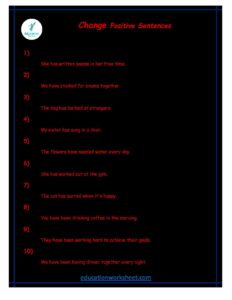Change the verbs into Present Perfect Continuous form positive
Description of Change the verbs into Present Perfect Continuous form positive
Converting verbs into the positive Present Perfect Continuous form is a crucial aspect of English grammar that allows us to express ongoing actions or activities that started in the past, have continued into the present, and are expected to continue into the future. In this comprehensive guide, we will explore the step-by-step process of changing verbs into the positive Present Perfect Continuous form, offering a detailed understanding of this grammatical transformation.
Understanding Present Perfect Continuous Tense: Present Perfect Continuous Tense is a verb tense used to describe actions or activities that began in the past, are still ongoing in the present, and are expected to continue into the future. This tense is constructed using the auxiliary verb “have” or “has” (depending on the subject), followed by “been,” and then the present participle form of the main verb (-ing form).
Step-by-Step Transformation:

- Identify the Original Verb: Start by identifying the verb that you want to change into the Present Perfect Continuous form. Let’s use the following example:
Original Verb: “work”
- Determine the Appropriate Auxiliary Verb: In the positive Present Perfect Continuous form, we use “have” or “has” as the auxiliary verb, depending on the subject. For example, if the subject is “I” or “they,” you would use “have,” while “he,” “she,” or “it” would require “has.”
- Convert the Verb to Its Present Participle Form: Change the original verb “work” into its present participle form by adding “-ing” to it. The present participle form of “work” is “working.”
- Construct the Present Perfect Continuous Sentence: Begin the sentence with the appropriate auxiliary verb (“have” or “has”) based on the subject. Follow it with “been” and then add the present participle form of the main verb.
Positive Present Perfect Continuous: “I have been working.”
- Understand the Resulting Sentence: The transformed sentence now expresses an ongoing action that began in the past (working) and is continuing into the present, emphasizing its duration and relevance.
Why Use Present Perfect Continuous Tense:
Present Perfect Continuous Tense is useful when describing actions or activities that started in the past, are still happening, and have a connection to the present. It allows us to convey the idea of duration and continuity, emphasizing the ongoing nature of the action or activity.
Example of change verbs to present prefect continuous form positive
Examples of Positive Present Perfect Continuous Sentences:
- “She has been studying all afternoon.”
- This sentence communicates that her studying began in the past, has continued throughout the afternoon, and is still ongoing.
- “They have been practicing the piano for hours.”
- Here, the use of Present Perfect Continuous emphasizes the continuous nature of their piano practice, which has been happening for an extended period.
- “I have been working on this project since last month.”
- This sentence highlights the ongoing effort put into the project, starting in the past (last month) and continuing into the present.


